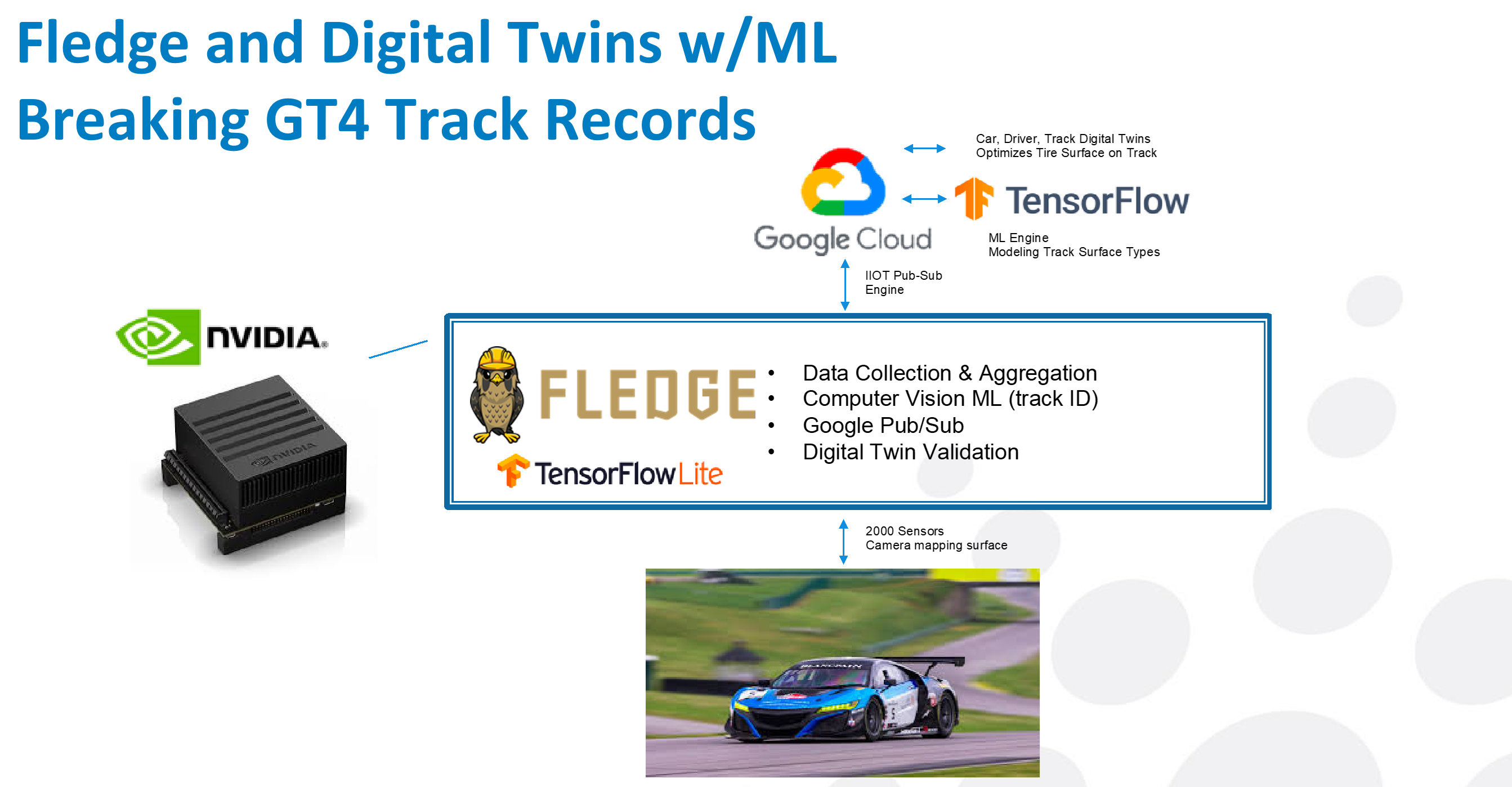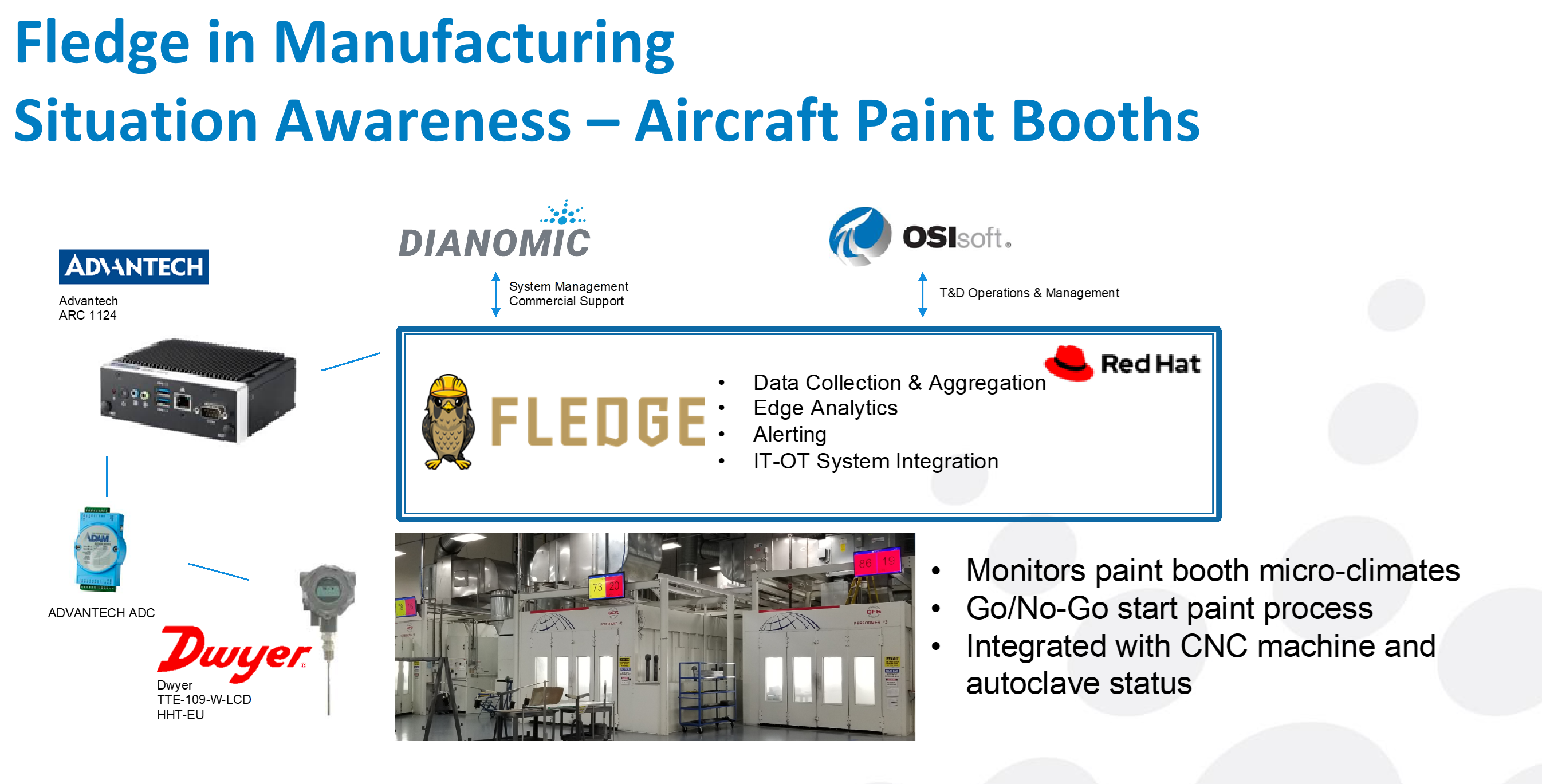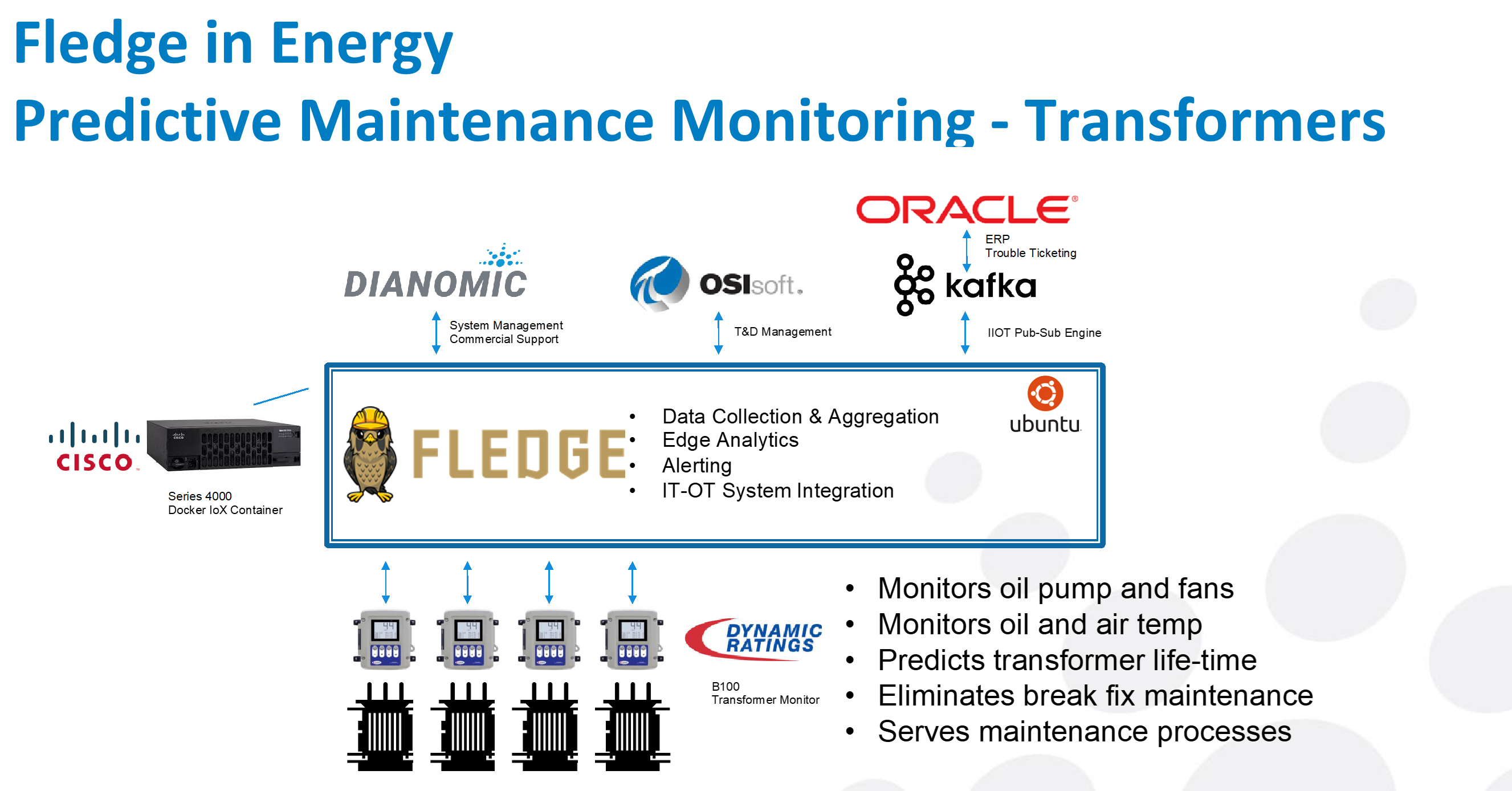
Owner: Daniel Lazaro <daniel.lazaro@aveva.com> Daniel Lazaro
LF Edge project(s) involved:
Fledge (Daniel Lazaro), EVE (Kathy Giori)
Description:
The OSDU Forum under The Open Group is developing an open source standards-based, technology-agnostic data platform that stimulates innovation, industrialized data management and reduces time to market. The OSDU Forum seeks to reduce data silos to enable transformational workflows, accelerate the deployment of emerging digital solutions for better decision making and create an open, standards-based ecosystem that drives innovation for the energy industry. The OSDU Edge group targeting intelligent edge analytics for oil & gas operators uses the LF Edge stack for drilling data analysis and edge to cloud integration. This showcase features a cross-consortia collaboration success story.
Video/presentation:
Call to action:
Please join our Fledge TSC meeting: https://lists.lfedge.org/g/fledge-tsc/calendar
How to install/use:
Current Adopters (or vaguely describe the adopter such as a major telco provider):
Major Oil & Gas Operators, OSDU, OSDU Edge Lab
Related talks/links:
Application of FLEDGE at Neuman Aluminium: An Industrial Use Case
Owner: Tom Arthur, Dianomic <tom@dianomic.com>
LF Edge project(s) involved:
Description:
AThe Neuman Aluminium Group is your global partner for high-quality aluminium solutions with 10 locations, over 3000 employees, over 200 years of experience. Multiple production facilities in Europe are controlled by a centralized MES (Manufacturing Execution System). The MES submits a production order to a facility. The machine processes the order and notifies the MES of the current production status. The MES sends data to a subsequent machine. Once the connection to the MES is lost, production will Continue as long as no new Input is required. The centralized nature of the system creates a critical dependency on the network connection!
The roadmap for connected production systems at Neuman includes open-source software stack to deliver device, core, application and supporting services for production equipment. Self-healing, scalable, up-gradable, flexible, platform independent and offline capable edge devices. Knowledge or/and ML driven smart edge devices to semi- autonomously control machine, forward data and adjust production equipment.
Fledge_Community_Presentation_22_09_2021.pptx.pdf
Video/presentation:
Meeting Recording - Minute 14:00
Call to action:
Please join our Fledge TSC meeting: https://lists.lfedge.org/g/fledge-tsc/calendar
How to install/use:
Current Adopters (or vaguely describe the adopter such as a major telco provider):
Related talks/links:
Meeting Recording - Minute 14:00
Fledge_Community_Presentation_22_09_2021.pptx.pdf
UC Davis and Opus One Using Fledge to Produce World Class Wine in Safer Conditions
Owner: Tom Arthur, Dianomic <tom@dianomic.com>
LF Edge project(s) involved:
Description:
During fermentation of juice to wine, the conversion of sugar to alcohol produces CO2 – about 64 liters of pure CO2 per 1 liter of juice. If not properly managed, the buildup of CO2 from fermentation actives can create a hazardous work environment. The OSHA permissible exposure limit of CO2 is 5000 ppm for 8 hours. Typically, CO2 in wineries is measured by a single or a few hard-wired sensors, however, the inherent variability of CO2 across a floor plan can be better monitored by a distributed network of sensors. Additionally, the use of batteries enables sensors to be easily installed anywhere in the winery. Temperature and humidity should also be measured, as these parameters give insight into the growth of unwanted microbials in the facility, the operation of the building HVAC and the evaporation of wine from barrels.
Originally developed by Dianomic Systems, Fledge joined LF Edge, an umbrella organization that aims to establish an open, interoperable framework for edge computing independent of hardware, silicon, cloud, or operating system. Fledge is an open-source Industrial IoT framework to collect sensor/machine data, transform, buffer and analyze the data on the edge, run edge ML models and reliably integrate the data with operational systems, OEE, MES, ERP, historians and the cloud. In a matter of weeks, UC Davis successfully built their custom sensor to cloud software IIoT solution using Fledge. A Custom printed circuit board (PCB) was designed and manufactured with the optimal components, form factor and price. A microcontroller with an integrated transceiver (CC1352r; TI) was used to create a Zigbee® mesh network. A low-power architecture was implemented to completely disconnect the microcontroller and sensors from the battery between measurements. A PCB antenna was designed to lower bill of material costs. A non-dispersive IR sensor measured CO2 while temperature and humidity were measured with a combined sensor from TI (HDC1080; TI).
Video/presentation:
Call to action:
Please join our Fledge TSC meeting: https://lists.lfedge.org/g/fledge-tsc/calendar
How to install/use:
Current Adopters (or vaguely describe the adopter such as a major telco provider):
UC Davis Robert Mondavi Wine center, Opus One
Related talks/links:
JEA compiled a list of IIoT use cases and business needs from electric generation, T&D, water, and wastewater and realized we needed a common approach for tackling similar needs from diverse business units, all running different Industrial Control Systems. FogLAMP provides a common framework for collecting the data and delivering it to PI and our analytics layer. This framework is open, standards-based and endorsed by the Linux Foundation. Alternatively, trying to integrate IIoT across multiple different proprietary DCS, PLC, and SCADA platforms was ominous and likely not even possible. FogLAMP offers a vendor-neutral alternative to the existing silos. JEA is taking an enterprise-wide approach to IOT and FogLAMP is a way to adopt a more modern standards-based and decoupled architecture for the future. Our first implementation monitors substation transformers and implements predictive maintenance using Dynamic Ratings B100 and disolved gas analyzers connected to FogLAMP running in a Cisco CAT 9300.
Rob Raesemann has an Electrical Engineering degree from the University of Florida and is one of the most experienced OSIsoft PI System consultants in the industry. He has 24 years of experience with PI across a wide range of industries.He bills himself as a "Full-Stack PI Guy" with experience ranging from architecting global PI deployments to developing applications using PI data. He has given several presentations at OSIsoft PI World and routinely competes and places in OSIsoft sponsored Hackathons where he has developed solutions using OSIsoft's PI System Access software suite of the PI AF SDK, PI Restful WebAPI using Microsoft .NET/C#, Angular Javascript Web Framework, and Python. He has been on the forefront of IIOT development as an early adopter of the FogLAMP framework developing Docker containers to be deployed on Cisco switches running the Cisco IOx IOT extensions. He has developed and contributed plugins to the FLEDGE project.
JEA IIOT Progress with FogLAMP and PI System with Live Q&A
Gradient Racing is a professional auto racing team based in Austin, Texas. One of Honda’s customers for NSX GT3 Evo, Gradient is committed to using cutting edge technology to gain an edge in GT racing.
Modern race cars have thousands of adjustable parameters in their suspension, aerodynamics, transmission and other systems. Finding the perfect configuration of these parameters for a given driver, track and race strategy is key to winning races. In GT racing, this has been more art than science, with drivers making multiple test runs and working with the race team to adjust the car based on feel.
Like Formula One and Nascar, Gradient wanted to bring state-of-the-art simulation technology to bear on this problem, believing that it would allow them to configure the car far more precisely. To do this, they engaged Motorsports.ai, a leader in racing modeling.
Motorsports.ai’s goal was to create a full simulation environment of the race: a simulated driver, a simulated car and a digital twin of the track. While car simulation software was commercially available, Motorsports.ai decided to use machine learning technology to develop an AI driver that would react to conditions in the same way as Gradient’s human driver.
Motorsports.ai deployed the Linux Foundation’s Fledge for three functions. First, to collect the massive amount of data required to train the machine learning system. Second, to validate the race simulations of car, driver and track. Last, to help validate the digital twin of each race track. Originally developed by Dianomic Systems, Fledge joined LF Edge, an umbrella organization that aims to establish an open, interoperable framework for edge computing independent of hardware, silicon, cloud, or operating system, last year. Fledge is an open-source Industrial IoT framework to collect sensor data, enhance it with meta information, run ML models on the edge and reliably transport data to central or cloud-based processing systems. In a matter of weeks, Motorsports.ai developed the plugins needed to interface Fledge with the race car’s CAN Bus and Eclipse Cyclone DDS interfaces to over 2000 in-car sensors.
Gradient used the Motorsports.ai simulation to optimize suspension and alignment settings for every race in 2019. The simulation enabled far more rigorous tuning than their previous manual method. Instead of building a configuration based on a few laps and driver “feel”, they were able to run tens of thousands of simulations using precise measurement. They were able to investigate conditions that had not yet been experienced on the actual track and ensure that they could compete effectively in them.
Winning GT3 Racing with LF Edge’s Fledge


A large defense and technologies company with more than 15,000 employees worldwide. They are a leading manufacturer of unmanned aerial vehicles (UAVs). These UAVs can be remotely piloted from anywhere in the world and are capable of very long duration, high altitude flights while carrying significant payloads. They are widely used by world militaries for intelligence, surveillance and offensive operations as well as by civilian organizations for border enforcement, firefighting and scientific applications.
The Need: UAVs are crafted from composite materials in an exacting process that demands high degrees of precision. If any step is executed under improper conditions, the entire aircraft may need to be reworked or even scrapped. The client wants to instrument every aspect of the manufacturing process to ensure that it is performed correctly and efficiently. By doing this, they expect to increase quality while reducing expenses from rework and scrappage. To completely monitor the production process, the client expects to deploy hundreds of sensors across multiple manufacturing stages. Data from these sensors must be available to personnel on the production floor, to supervisory personnel and for historic review.
The Solution: The key requirement for the project was a data management solution that could collect readings from hundreds of heterogeneous sensors and reliably transmit information to the multiple information systems that require it. To accomplish this, the client selected Fledge supported by Dianomic Systems. Fledge is an LF Edge Open Source project for industrial IoT that collects data from sensors, processes it at the edge, alerts and delivers it to data systems or the cloud. The client integrated Fledge with their existing operational systems to provide central monitoring and historical archiving. The initial stage of the project was to monitor the UAV painting process. UAVs are painted with multiple layers of primer and topcoat. These must be applied within strict ranges of temperature and humidity to ensure proper drying and curing. The client instrumented each paint booth with 4 temperature and humidity sensors one set in each corner. These sensors are attached to A/D converters and then to Fledge software running on Advantech Embedded IoT Gateways.
Fledge software converts the sensor readings to JSON format and reliably delivers the data to OSIsoft PI. In addition, Fledge connects with local displays at each paint booth to display temperature and humidity information on the factory floor. The display is green/red color coded to alert production personnel when environmental conditions are appropriate to begin the painting process.
The Results: Fledge-based monitoring has enabled the client to optimize the UAV painting process. Production now immediately begins when environmental conditions are met, eliminating the delays caused by manual measurement and communication. Supervisory personnel are alerted when conditions move outside specifications and can immediately rectify the situation. Further, manufacturing engineering now use historical data on temperature to better plan cycle times and to identify cost saving opportunities such as insulation and cooling devices. With the pilot project complete, the client is now moving towards their vision of complete visibility into the entire production process. Fledge’s open architecture will enable them to easily integrate the large numbers of varied sensors needed to ensure their operations are highly reliable and productive.
The next stage is to monitor autoclaves as they press and cure composite materials into UAV components. The client wants to review autoclave operations to ensure they have precisely executed the series of temperature/pressure/time stages necessary to eliminate bubbles and create structurally sound components. With the Fledge and PI infrastructures already in place, deploying monitoring for this process will be as simple as attaching additional pressure and temperature sensors to the Fledge gateways.
Link to Recording (Disclaimer: Foglamp instead of Fledge is used since it predates Fledge 1.8).

This Fledge client is one of the largest community-owned electric utility companies in the United States, servicing nearly 500,000 customers in the United States. It operates five generating plants, about 750 circuit miles of transmission lines and nearly 7,000 miles of distribution lines. It also purchases energy from several solar sites located across its service territory, including one producer with more than 200,000 solar panels.
The electrical utility spends millions of dollars on transformer maintenance each year. Much of this expense results from emergency responses to restore service due to failures in the field. They wanted to reduce these reactionary expenses and move to a proactive model where they could forecast systems requiring maintenance before failures actually occur. This will allow them to decrease outages while saving money by using their maintenance crews more effectively. Proactive maintenance requires a great deal of instrumentation and trend data on each transformer. This information needs to be available to multiple organizations across the enterprise for planning, analytics, monitoring and scheduling.
The company decided that IIoT technology offered the best solution for this project. While they considered leveraging existing SCADA systems, they determined the cost to scale the hardware and licenses for these systems would be excessive. Further, security and NERC CIP regulatory concerns made it challenging to provide broad access to data residing in SCADA. Because of this, they decided to focus their SCADA systems on operation and controls and to use IIoT for condition-based monitoring and maintenance.
The company deployed Dynamic Ratings B100 Electronic Temperature Monitors at their substations. These measure power transformer top oil temperature and LTC temperatures and calculate winding temperatures. In addition, they made use of existing fan sensors to monitor ambient temperature.
To manage the edge data, the utility deployed Fledge, the Linux Foundation’s industrial IoT edge project supported by Dianomic Systems. Fledge is an open, industry-wide solution for monitoring the Internet of Things that collects data from sensors, processes it at the edge, alerts and delivers it to data systems or the cloud. Fledge’s open-source architecture provides a rapid, low-cost way to achieve complete visibility into information needed by businesses to operate more reliably and productively.
Fledge collects data from multiple B100s at the substation. It reliably delivers the data to OSIsoft PI for long-term trending, visualization, advanced analytics and event detection.
Because of Fledge’s open nature, the company was able to deploy it on their existing Cisco 4000 integrated services routers, saving the expense of additional ruggedized hardware.
Fledge-based monitoring has enabled the utility to move to a much more proactive maintenance strategy. From OSIsoft PI, they can now detect the warning signs of transformer core, coil and LTC switch failures. Further, PI analytics can calculate cumulative thermal aging of the transformer to forecast life expectancy. Crews can be scheduled to perform maintenance before a failure occurs, resulting in much lower costs and less downtime.
The implementation has proven to be highly cost effective. Fledge’s flexibility enabled the company to leverage all its existing edge and back-end systems. Other than sensors, no new hardware was required for the deployment.
The utility plans to leverage Fledge’s flexibility to support additional IIoT use cases for field data management, integrating additional sensors and edge-based analytics to identify service requirements. Using Apache Kafka, Fledge will integrate with Oracle ERP to automatically generate maintenance work orders.
Link to Recording (Disclaimer: Foglamp instead of Fledge is used since it predates Fledge 1.8).